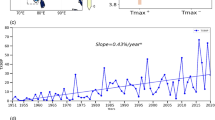Summary
The existence of a major zonal mountain belt may be an important climatic agent during glacial periods. The combined effect of a large-scale ice field and a zonal mountain chain south of it, might contribute to the relative warming of the polar regions as the result of the increased poleward heat transport due to enhanced wave activity.
Similar content being viewed by others
References
Chung-Muh Tang: The Influence of Meridionally Sloping Topography on Baroclinic Instability and Its Implications for Macroclimate. J. Atm. Sci., 33 (1976), 592.
H. C. Davies: Climatic Change, Orography and Geostrophic Motion. Arch. Meteor. Geoph. Bioklim., Ser. B, 23 (1975), 1.
K. Gambo: The Topographical Effect upon the Jet Stream in the Westerlies. Vortex, No 1, Tokyo 1956.
G. J. Haltiner: Numerical Weather Prediction. J. Wiley & Sons, Inc., New York etc. 1971, 122–124.
Author information
Authors and Affiliations
Rights and permissions
About this article
Cite this article
Vítek, V. Comments on the influence of a meridionally sloping topography on the development of wave disturbances. Stud Geophys Geod 21, 414–416 (1977). https://doi.org/10.1007/BF01613277
Received:
Published:
Issue Date:
DOI: https://doi.org/10.1007/BF01613277




